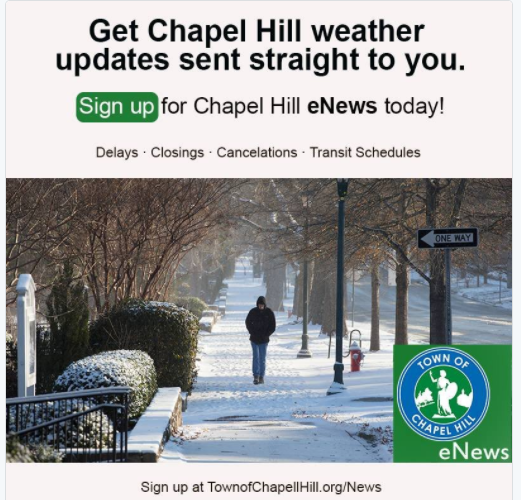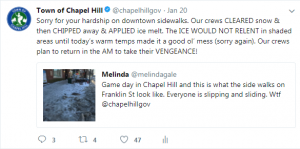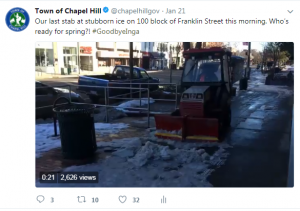
Community emergencies are obviously challenging and stressful, and yet they can also be opportunities for local governments to earn trust and boost engagement.
Dangerous weather is something that all people experience — together. What we learn from our organization’s ability to share information, listen, empathize, encourage and respond during a weather emergency can have lasting benefits long after the storm has passed.
When Winter Storm Inga dumped about 10 inches of snow in Chapel Hill (Jan. 17, 2018), our @ChapelHillGov communication channels and engagement processes were put to the test. A few takeaways from our winter weather emergency are worth remembering as we move into a year with a number of local government goals for community engagement.
1. Speak early, speak often, share as much as you can.
You really cannot communicate too much during an emergency. This means communicating before, during and after the crisis. Initially, we inform our community that a storm is coming and share our preparations. We let people know where they can find information.
After the snowfall, we gave frequent updates. We kept busy all our social media channels – Facebook, Instagram, Twitter and NextDoor, while updating our website emergency banner and issuing twice-daily updates to our email subscribers to Chapel Hill eNews. All our public messages were distributed first to the Town Council, leadership and employees.
We brought residents inside the Emergency Operations Center with Facebook Live reports to hear directly from the fire chief, public works director and emergency management coordinator.
Our primary message was to urge motorists to stay off the roads due to hazardous conditions. Power outages were not widespread. Thankfully, the snow was forecast well ahead of time, and schools were closed.
While developing our messaging, we put ourselves in the shoes of our residents. When residents are inside and wondering about the condition of the roads, photos and videos of road conditions may be the best information we can provide. Among the visuals we shared — beautiful snowfall, residents at play, road conditions, vehicle wrecks, public safety personnel and public works crews at work.
2. The quality of our engagement will be judged not on our communication tools or public information — but on our ability to listen.
The questions we heard or anticipated over the course of the storm included:
- Is everyone OK?
- Who is in charge?
- What are the condition of the roads?
- What’s open and what’s closed?
- When will my street be plowed?
- When will my garbage be collected?
- When can I get back to normal?
We listened. And we listened across all our social media channels and in direct email messages. And something new for us — we established a Call Center, which received about 175 calls over two days. The people staffing this center reported that while they didn’t always have an answer, their ability to listen and show understanding was appreciated.
“Many of the questions we received were about plowing the streets and collecting the trash, but many other people simply wanted to speak to another human being — and know that we care,” said Anita Badrock, a human resource development employee who staffed the call center.
3. Close the feedback loop and be accountable
By Saturday, the major roads had all been plowed more than once, but many neighborhood streets and downtown sidewalks were still iced over, especially in shaded areas. Saturday was game day with the North Carolina men’s basketball game against George Tech — and downtown Chapel Hill was bustling with fans.
That’s when we received criticism that downtown sidewalks were still choppy with crusty snow and ice. We responded by acknowledging the issue, accepting responsibility — and promising action.
We closed the loop the following morning on this particular issue by showing that we took action. The engagement on this tweet was much higher than what we typically see.
Even those crises that are not large in scale are an opportunity to test your organization’s ability to weather the engagement storm. After largescale events like these, we always see an increase in our number of followers on our various communication channels. As we move into beautiful springtime, we hope to serve them in the same manner as during emergencies – sharing, listening, empathizing, encouraging and responding.
That’s the update from Chapel Hill, where we’re looking forward to seeing the daffodils!





